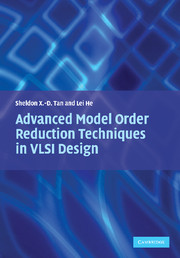Book contents
- Frontmatter
- Contents
- Figures
- Tables
- Foreword
- Acknowledgments
- 1 Introduction
- 2 Projection-based model order reduction algorithms
- 3 Truncated balanced realization methods for MOR
- 4 Passive balanced truncation of linear systems in descriptor form
- 5 Passive hierarchical model order reduction
- 6 Terminal reduction of linear dynamic circuits
- 7 Vector-potential equivalent circuit for inductance modeling
- 8 Structure-preserving model order reduction
- 9 Block structure-preserving reduction for RLCK circuits
- 10 Model optimization and passivity enforcement
- 11 General multi-port circuit realization
- 12 Reduction for multi-terminal interconnect circuits
- 13 Passive modeling by signal waveform shaping
- References
- Index
8 - Structure-preserving model order reduction
Published online by Cambridge University Press: 19 January 2010
- Frontmatter
- Contents
- Figures
- Tables
- Foreword
- Acknowledgments
- 1 Introduction
- 2 Projection-based model order reduction algorithms
- 3 Truncated balanced realization methods for MOR
- 4 Passive balanced truncation of linear systems in descriptor form
- 5 Passive hierarchical model order reduction
- 6 Terminal reduction of linear dynamic circuits
- 7 Vector-potential equivalent circuit for inductance modeling
- 8 Structure-preserving model order reduction
- 9 Block structure-preserving reduction for RLCK circuits
- 10 Model optimization and passivity enforcement
- 11 General multi-port circuit realization
- 12 Reduction for multi-terminal interconnect circuits
- 13 Passive modeling by signal waveform shaping
- References
- Index
Summary
Introduction
The integrated circuit industry has continuously enjoyed enormous success owing to its ever increasing large-scale integration. With the advent of system-on-a-chip (SOC) technology [30,133], it requires heterogeneous integration to support different modules within one single silicon chip such as logic, memory, analog, RF/microwave, FPGA, and MEMS sensor. Such a heterogeneous integration leads to highly non-uniform current distribution across one layer or between any pair of layers. As a result, it is beneficial to design a structured multi-layer and multi-scale power and ground (P/G) grid [11] that is globally irregular and locally regular [115] according to the current density. This results in a heterogeneously structured P/G circuit model in which each subblock can have a different time constant. In addition, the typical extracted P/G grid circuits usually have millions of nodes and large numbers of ports. To ensure power integrity, specialized simulators for structured P/G grids are required to efficiently and accurately analyze the voltage bounce or drop using macro-models.
In [139], internal sources are first eliminated to obtain a macro-model with only external ports. The entire P/G gird is partitioned at and connected by those external ports. Because elimination results in a dense macro-model, [139] applies an additional sparsification procedure that is error-prone and inefficient. In addition, [18,95] proposed localized simulation and design methods based on the locality of the current distribution in most P/G grids with C4-bumps.
- Type
- Chapter
- Information
- Advanced Model Order Reduction Techniques in VLSI Design , pp. 137 - 157Publisher: Cambridge University PressPrint publication year: 2007



